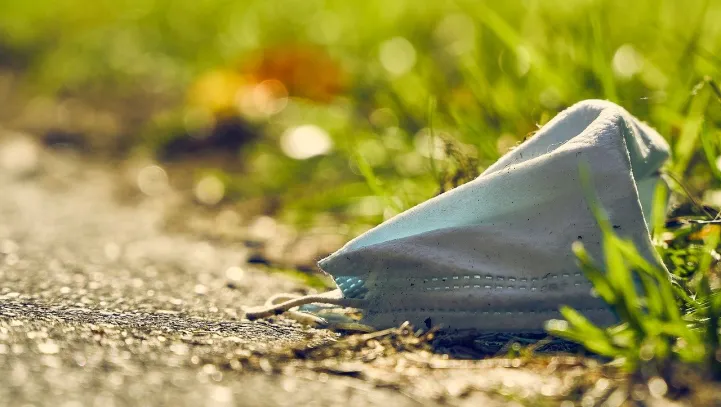Blog

COVID-19 Response Efforts Lead to Negative Environmental Impacts
Shortly after the outbreak of COVID-19 researchers began looking into how environmental factors, such as heat and sunlight, influenced the spread of the virus. Now new studies are emerging that focus on the effect of the COVID-19 response on the environment. These studies are showing both positive and negative impacts as a result of the COVID-19 response. This post will focus on some of the negative effects of the COVID-19 response.
INCREASES IN SOLID WASTE
Waste management technologies are critical for human health and development. Before the spread of COVID-19, the world was facing problems in waste collection and disposal. These challenges have increased with the spread of the virus. The measures implemented to stop the spread have caused an increase in waste sent to landfills. For example, stay-at-home orders led to “panic buying” in the early months of the pandemic. This “panic buying” of paper products and groceries has led to an increase in disposal of perishable and other household items. The pandemic has also led to an increase in online shopping, which in turn results in an increase in waste. This comes not only from the products themselves but also from the shipping materials. The result is an increase in household waste generation.
Changes in recycling have also led to an increase in waste amidst the pandemic. While there are few places that stopped recycling completely, many places changed the way recycling is handled. Many countries, including the United States, postponed or restricted recycling programs to reduce the transmission of the virus. In other places, recycling is sent directly to the landfill or the sorting of recycled materials has stopped. Due to changes in the recycling market, most of the waste generated is disposed of rather than recycled.
The increase in solid waste generation and changes in recycling practices have led to issues for landfills worldwide. Waste is no longer being separated as it was before the pandemic. Non-segregation of waste can lead to an increase of hazardous waste at landfills. This requires changes in the collection, storage and treatment processes at landfills. Changes in recycling have frustrated efforts to reduce plastic pollution, ultimately leading to negative impacts such as nonbiodegradable plastics in our waterways. Other waste disposal techniques are also being evaluated to manage the amount of waste being generated. Disposal techniques, such as open burning and incineration of waste, pose additional environmental challenges.
INCREASES IN BIOMEDICAL WASTE
The testing, diagnosis and treatment of the COVID-19 virus has led to an increase in medical waste. Some forms of waste include masks, gloves, needles, and other hospital supplies. The use of personal protection equipment (PPE) manufactured from single use plastics has also led to an increase in medical waste. Waste from single-use PPE is generated in both hospitals and households. Examples of single-use PPEs include protective gloves, facemasks, and protective shields.
The increase in medical waste has also led to problems with disposal, which in turn has affected the environment. Improper management of medical waste may expose health care workers, patients and waste management workers to infection, pollution, and other injuries. This haphazard disposal can also cause many issues for the environment. Improper disposal has caused issues such as clogging of waterways and piles of masks on beaches and hiking trails. PPE products are often made from polypropylene. This creates a danger for aquatic life who often mistake polypropylene for food. Polypropylene is a compound that can last for a long time and release dioxin into the environment.
INCREASED USE OF DISINFECTANTS
The elimination of COVID-19 through sterilization and disinfection. Sterilization methods, such as UV-light and dry heat, have been used in hospitals, but are not widely available. As a result, most people have turned to disinfection to eliminate the virus. Common disinfectants include alcohols, chlorine, and chlorine compounds, standard and improved hydrogen peroxide, and quaternary ammonium compounds. Disinfection methods have been used in hospitals, households, and outdoor areas during the pandemic. In some countries, large amounts of disinfectants were applied into roads as well as commercial and residential areas in order to eliminate the virus. The use of disinfectants was increased in wastewater treatment after the presence of the virus was identified in wastewater.
Disinfectants used to stop the spread of COVID-19 can have lasting effects on the environment. They are widely available and cost effective, but their widespread use can have lasting negative impacts. Disinfectants kill both targeted bacteria and non-targeted bacteria. Some of the non-targeted bacteria include beneficial bacteria. The elimination of beneficial bacteria may create an ecosystem imbalance. In addition, the overuse of disinfectants can create harmful byproducts. For example, the excessive use of chlorine in wastewater treatment can lead to harmful byproducts in water ways.
CONCLUSION
As the COVID-19 response continues, its effect on the environment will become more apparent. These effects can lead to changes in practices and regulations governing waste disposal. Knauf Shaw LLP has experience with regulations regarding waste disposal. For questions on waste disposal regulations, please contact our office.
Sources
• N. Kumar Rai, et al. 2020. Consequences of chemical impact of disinfectants: safe preventive measures against COVID-19. https://www.tandfonline.com/doi/full/10.1080/10408444.2020.1790499?af=R&
• Tanjena Rume, et al. 2020. Environmental effects of COVID-19 pandemic and potential strategies of sustainability. https://www.ncbi.nlm.nih.gov/pmc/articles/PMC7498239/
• How does the Environment Impact COVID-19? https://www.dhs.gov/science-and-technology/news/2020/10/29/feature-article-how-does-environment-impact-covid-19
• Samuel Asumada Sarkodie. 2020. Impact of COVID-19 pandemic on waste management. https://www.ncbi.nlm.nih.gov/pmc/articles/PMC7447614/#:~:text=Failure%20to%20properly%20manage%20the,to%20toxins%20(WHO%202020).
• Weathering the Essential: A Look Inside the COVID-19 Impact on the Waste and Recycling Industry. https://www.waste360.com/business/weathering-essential-look-inside-covid-19-impact-waste-and-recycling-industry